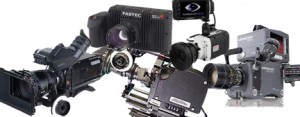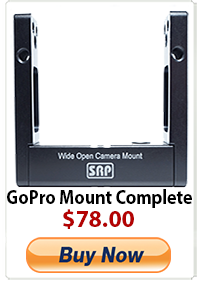High-Speed
I am going to preamble my post by saying right off the bat that I am a high-speed snob and am biased since one of the companies I am affiliated with is the US distributor for the TS3Cine.
I am a high-speed snob not in regards to resolution or ISO but rather in how a high-speed camera should behave and record content. There are several high-speed solutions in the marketplace. Some are targeted at the film and video arena which we all are apart of and others are more-so targeted at military and scientific applications. In reality all these cameras have a base in analytic’s and military use but many have been modified or changed to suit our market.
There are a few key features to true high-speed cameras that are fairly universal.
1) High-Speed cameras have image memory traditionally between 2-16gB that must be written after each take to either onboard storage (in whichever form), offboard storage, or a solid state or video recorder via HD-SDI, HDMI, or other video interface.
2) They use trigger points that can be assigned. Usually these are adjustable between start, mid and end. These trigger points allow you to tell the image memory / buffer that when you press the trigger button either the camera will have started immediately, started with head room or tails, or after the event has already happened. The benefit of an adjustable trigger is to capture an event that you can either anticipate or react to and still get it.
3) Black Balance. True high-speed cameras get hot. They all have a cooling system that involves either heat sinks, heat pipes, fans or a combination of some or all of these cooling technologies. When the camera gets hot the sensor reacts differently. This can cause color and image anomalies like lines, patterns or color shifts.
4) True high-speed cameras have the ability to record image stacks. These image stacks can be a group of jpegs, TIFFs, DNG files, etc. The benefit of these stacks instead of a video file is that the frame rate is not baked in. Nether is a video codec. The advantage of doing that is that you can make deliverables for multiple worldwide clients (pal, secam, ntsc) and multiple frame rates (23.98, 24, 25, 29.97, 30, 50, 60, etc). You no longer have limited your market. If you shoot high-speed for stock footage sales this is a must to be able to do image stacks. You cannot do that with the FS700 for example.
Although I work for a company that sells and rent’s the FS700 I feel that it is unfair to call or market it as a high-speed camera. Anything beyond 250FPS on the camera does line skipping and doubling to achieve an up-scaled 1080p output. When you get to the higher frame-rates the image looks very noisy and the up-scaling is very evident. The FS700 is a great all around camera but is not really considered a high-speed camera by our clients or most rental houses.
The Red Epic has the ability to shoot 300fps at 2k which is pretty remarkable. The problem is its baked in like the FS700. Meaning you cannot change the frame-rate after the fact (except via twixtor, etc) thus it is very limiting.
Although I love the Arri Alexa Plus the 120fps option simple does not make it a high-speed camera in my book. It is also the reason I did not include other cameras with 60-120fps options. They are also baked in as well with limited post opportunities although I like that the Alex will do 120fps with c-log in Arri RAW.
Here are a few true high-speed solutions that are common in our field at the current time:
The Vision Research Phantom Flex. The Phantom Flex is the pinnacle of high-speed cameras for broadcast and film. The high frame rate 2456fps @ 1080p, amazing low light sensitivity, hd-sdi output, simple trigger points, RAW workflow options, PL mount, etc make the camera the premiere choice when budget, camera size and workflow are not as much of a concern. The camera uses Cinemags to record to which is a high speed flash memory system that offloads footage from the camera’s memory to the mag within seconds. You can also offload the memory between shots to a KiPro mini or other devise as well. Like all high-speed cameras if the power is disconnected before you write your shot to a Cinemag or offboard recorder you will loose the take. The Flex does not feature a power button so when its plugged into an AC or DC source the camera is on. The Flex takes approximately 3o minutes to warm up and like most high-speed cameras it requires black balancing (ideally between each shot) to ensure image integrity and color balance. The flex has controls built into the camera with an in-depth menu but a PC computer is required to change things like the video output settings and other controls that the on-board menu cannot adjust. The camera requires a fair amount of voltage and you cannot really run and gun with it. Anton Bauer VCLX block batteries is the typical power solution for the Flex. The Phantom Flex pricing varies and typically prices out at approximately $150K well equipped (without glass and power of course) and rents for approx $2500 (base) / day from most rental houses.
Weisscam HS2 shoots 2000fps at 1080p and 4000fps at 720p. The camera is a little harder to find in rental houses as it is not as popular as a Flex for example but it is still one of the best high-speed options if you have the money to rent it. Much like the flex it uses a digital mag system for transferring between image memory and solid state storage. The camera is fairly large and uses 24volts for power. Clairmont Camera, PC&E, Arri CSC and the Camera House all rent Weisscam. The rental rate is around the same as the flex at approx $2500/day
The Vision Research Phantom Miro 320. Basically the 320 needs to be Abel Cine ized as I like to call it to make it a user friendly solution. Think of the Miro 320 as a mini Flex that runs on Sony BP series 12v batteries. The main difference outside of the obvious size is the fact that the 320 does not have any controls on the camera. An external controller is required to control the camera and to trigger it. The controller is fairly small and can be mounted to the handle kit. The 320 has a variety of lens mounts and is priced at approx $75K well equipped and ready to shoot. The Miro 320 rents for approx $1,500/day from Abel Cine Tech
The Fastec / Rule TS3Cine (my bias will show) is a portable high-speed camera which is self contained. Unlike most high-speed cameras it features a built in 7″ touch screen monitor. A computer is not required for its operation. It can record in AVI, TIFF, JPEG and Cinema DNG RAW. Unlike the Flex and the Miro 320 the camera is not 1080p but rather 1280×1024. This might seem like a problem for some but for those who have shot with it feel the compact self contained form factor and ease of use outweigh the resolution. The square 1″ sensor allows for anamorphic opportunities as well. The TS3Cine runs for approx 4 hours on a single removable battery. Pricing is $22,950 for the 128GB version and $23,995 for the 256GB version. The camera rents for approx $667/day at Rule Boston Camera, Birns and Sawyer and Cinequipt (other rental houses are to be announced very soon)
Typically high-speed cameras have been expensive to rent but that is changing. Training etc has also been expensive but with other solutions in the market those prices have also come down and have put high-speed into the hands of the masses. Traditionally shooting high-speed was often done with film cameras like the Photosonics Action Master series as well as with Hicam and Locams etc. If you have not had the opportunity to shoot high-speed you should. Yes at first you may be inclined to shoot face slaps, balloon pops, etc but after a while you will see applications for beauty, time locking and other artful applications.
I will be at Masters in Motion this year teaching the hands on workshop for the Phantom Flex camera and the TS3Cine camera. If you are already signed up, it will be great meeting you and teaching you the fundamentals of high-speed with these two amazing pieces of equipment. For those who have wanted to learn or get a class on these cameras, Masters in Motion (Austin TX Dec 3-5th) http://shooteditlearn.com/register/ is a great deal and will cost you basically the same price as it would be for a few days of Phantom training.
If you have any questions on high-speed etc, feel free to email me ( mike at mns1974 dot com) or comment here.
Mike Sutton
Follow me on Twitter: MNS1974
-
Luke
-
Nick







